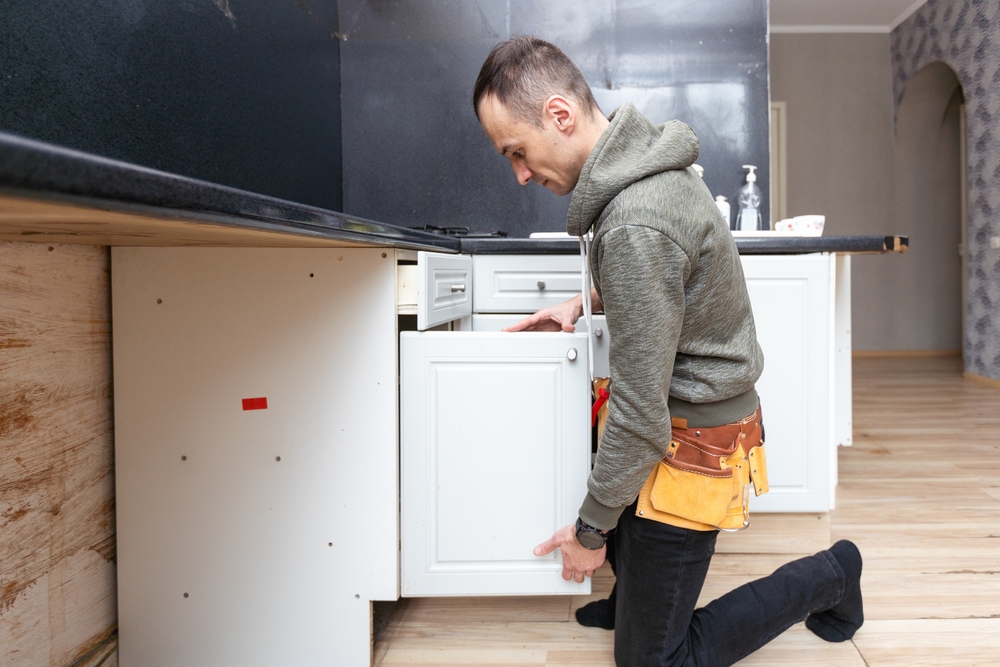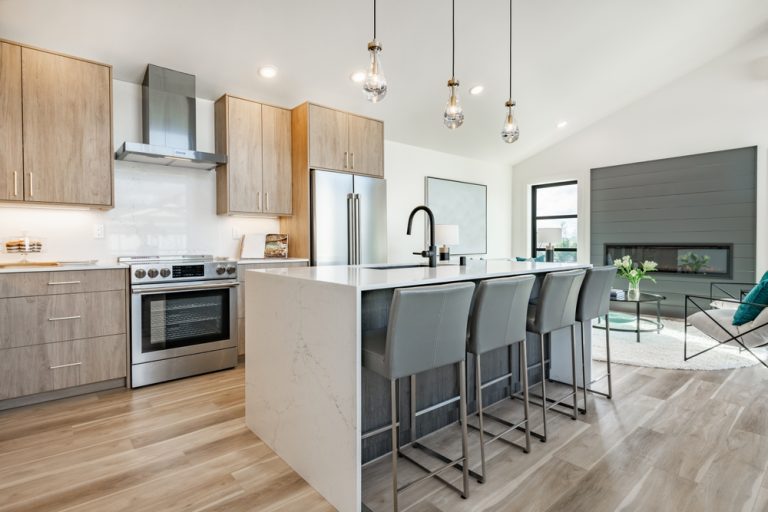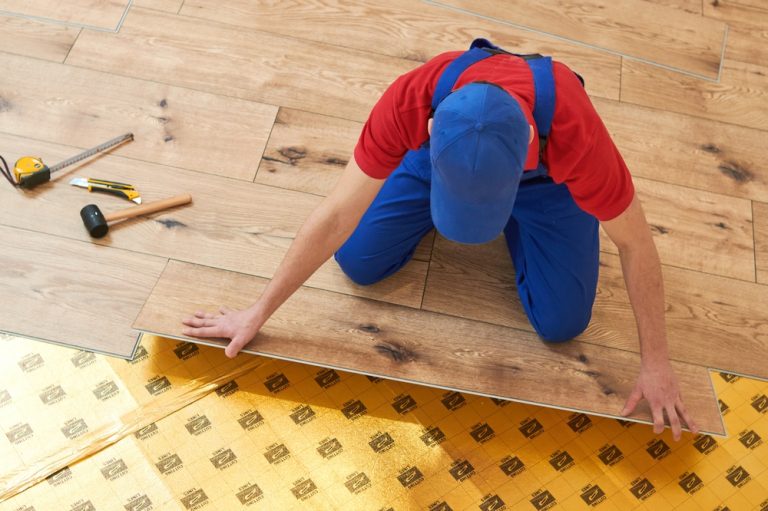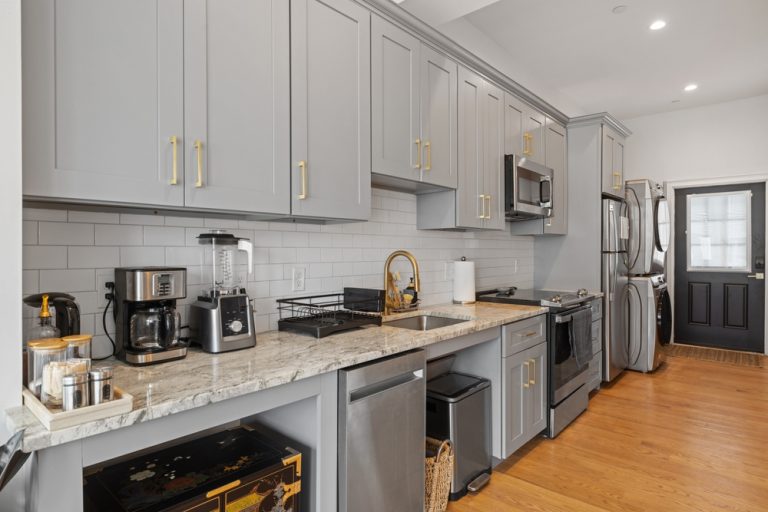Do You Have to Remove Cabinets to Replace Kitchen Flooring?

When considering a kitchen renovation, one question that often arises is, do you have to remove cabinets to replace kitchen flooring? Replacing flooring in a kitchen can be a significant project, and it’s natural to wonder if removing cabinets is necessary or if the flooring can simply be installed around them. The decision largely depends on the type of flooring, the condition of the cabinets, and the overall scope of the renovation.
In this blog, we’ll explore whether you need to remove your cabinets to replace kitchen flooring and factors to consider when making your decision.
Why Removing Cabinets May Not Be Necessary?
In many cases, the cabinets in your kitchen do not need to be removed when replacing the flooring. This can save you time, labor, and money during the renovation process.
Floating Floors
If you’re installing a floating floor, such as vinyl planks or laminate, there’s no need to remove the cabinets. These types of flooring are designed to be installed over the existing floor or subfloor and do not require attachment to the cabinets or subfloor itself. Floating floors “float” over the surface, which means they can be installed around the base of the cabinets without disturbing them.
Tile or Hardwood Replacement
Similarly, if you’re replacing tile or hardwood flooring and plan to use the same materials, you can often leave the cabinets in place. You’ll simply need to cut the new flooring to fit around the cabinets, making sure to account for expansion gaps or any necessary adjustments.
Saving Time and Cost
One of the primary advantages of not removing cabinets is the savings in both time and cost. Removing and reinstalling cabinets can add considerable expense to a renovation project, especially if your cabinets are custom-built or have intricate designs. By leaving the cabinets in place, you can focus solely on the flooring replacement, making the process quicker and less expensive.
Also Read – What Colour Flooring Goes with a Grey Kitchen?
When Removing Cabinets Is Necessary?
While there are situations where cabinets don’t need to be removed, there are also instances where removing the cabinets is necessary or highly recommended when replacing kitchen flooring.
Subfloor Damage
If the subfloor beneath your kitchen flooring is damaged or uneven, you may need to remove the cabinets to repair or replace the subfloor properly. In this case, leaving the cabinets in place could result in an uneven floor that may cause issues with the new flooring installation, particularly with materials like tile or hardwood.
Raising Floor Height
When the new flooring significantly raises the height of the kitchen floor, it might be necessary to remove or adjust the cabinets. For example, if you’re switching from a thin laminate floor to a thicker tile or hardwood, the change in height could affect the alignment of the base cabinets and appliances. In this situation, the cabinets may need to be removed, adjusted, or trimmed to accommodate the new floor height.
Comprehensive Renovation
If you’re planning a full kitchen remodel that involves changing the layout, countertops, or appliances, it’s often easier to remove the cabinets and replace the flooring before reinstalling new or updated cabinetry. This approach ensures that the flooring runs continuously throughout the kitchen, eliminating the need to cut and fit around individual cabinets.
Pros and Cons of Removing Cabinets for Flooring Replacement
When deciding do you have to remove cabinets to replace kitchen flooring, it’s important to weigh the pros and cons of each option.
Pros of Removing Cabinets
- Continuous Flooring: Removing the cabinets allows you to install the flooring across the entire kitchen, creating a seamless, continuous look.
- Easier Installation: Without cabinets in place, the flooring installation process is simpler and faster, as there are fewer cuts and adjustments needed.
- Subfloor Access: If the subfloor needs to be repaired or replaced, removing the cabinets provides full access to the entire surface, ensuring a level and stable foundation for the new flooring.
Cons of Removing Cabinets
- Increased Cost: Removing cabinets adds both time and cost to the renovation project, especially if the cabinets need to be reinstalled or replaced after the flooring is installed.
- Additional Labor: Taking out cabinets can be labor-intensive and may require professional help to avoid damaging the cabinetry or countertops.
- Complexity with Appliances: Removing cabinets might require disconnecting and moving appliances like the dishwasher, which can complicate the renovation process.
Types of Flooring and Cabinet Removal Considerations
When deciding do you have to remove cabinets to replace kitchen flooring, the type of flooring you choose can influence whether or not cabinets need to be removed.
Tile Flooring
For tile flooring, cabinets can generally stay in place during the installation. The tile is cut to fit around the base cabinets, and any gaps are filled with baseboards or trim. However, if the subfloor needs attention, the cabinets may need to be temporarily removed.
Vinyl Plank or Laminate Flooring
Vinyl plank and laminate flooring are floating floors, which means they can be installed without removing cabinets. These floors are designed to expand and contract with temperature changes, so leaving a small gap around the cabinets is recommended.
Hardwood Flooring
For hardwood flooring, cabinets don’t usually need to be removed unless there is significant subfloor damage or a dramatic change in the floor height. The wood planks are cut to fit around the base cabinets, creating a continuous and attractive appearance.
Engineered Wood Flooring
Similar to hardwood, engineered wood can be installed without removing the cabinets. However, if you’re concerned about raising the height of the kitchen floor or want a completely seamless look, removing the cabinets might be a good option.
Final Considerations for Replacing Kitchen Flooring
When planning a kitchen flooring replacement project, there are a few additional factors to keep in mind:
Height Adjustments
If you’re raising the height of your kitchen floor, ensure that the base cabinets and appliances will still fit properly. In some cases, you may need to trim the bottom of the cabinets or adjust the toe kicks to accommodate the new flooring height.
Appliance Fit
Remember that appliances like the dishwasher and refrigerator may be affected by the new floor height. If the flooring is significantly thicker than the old material, these appliances may no longer fit properly under the countertop.
Professional Installation
For complex flooring installations or situations where the subfloor needs repair, it’s often best to hire a professional. A licensed contractor or flooring expert can assess your kitchen and recommend the best approach, whether it involves removing cabinets or not.
Conclusion
So, do you have to remove cabinets to replace kitchen flooring? In most cases, the answer is no—cabinets can remain in place for many types of flooring installations, such as vinyl plank, laminate, or tile. However, there are situations where removing cabinets is necessary, particularly if the subfloor needs repair or if the new flooring significantly raises the height of the kitchen floor.
Ultimately, the decision depends on the type of flooring, the condition of the subfloor, and the scope of the renovation. By considering these factors, you can determine the best approach for your kitchen flooring project.




